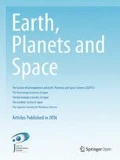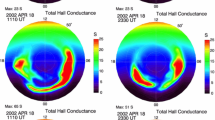Abstract
The scalar anomaly field determined from available Ørsted data is compared with the upward continued scalar anomaly field derived from Magsat data. Two techniques were used to remove the core field from the Ørsted satellite data. In the first method, monthly spherical harmonic core field models of degree and order 13 derived from scalar and vector data were subtracted, and in the second method, along-track high-pass filtering of scalar data only was used. In both methods, the binned residuals were interpolated to a sphere, and subsequently filtered. Monthly degree and order 13 spherical harmonic core field models were removed from Magsat vector data. The binned Magsat vector residuals were interpolated to a sphere, filtered, and upward continued by high degree spherical harmonic analysis. The corresponding Magsat scalar anomaly field at Ørsted altitude was then determined. For latitudes below 50 degrees, removal of the core field by signal processing techniques from presently available Ørsted data led to a scalar anomaly field in better agreement with that determined from Magsat data, than removal by spherical harmonic analysis.
Similar content being viewed by others
References
Arkani-Hamed, J., R. A. Langel, and M. Purucker, Magnetic anomaly maps of the Earth derived from POGO and Magsat data, J. Geophys. Res., 99, 24075–24090, 1994.
Backus, G., R. Parker, and C. Constable, Foundations of Geomagnetism, p. 140, Cambridge University Press, 1996.
Cain, J. C., Z. Wang, C. Kluth, and D. R. Schmitz, Derivation of a geomag netic model to n = 63, Geophys. J. Int., 97, 43–441, 1989.
Kaiser, J. F., Nonrecursive digital filter design using window function, in Proceedings of the 1974 IEEE International Symposium on Circuits and Systems, pp. 20–23, IEEE, New York, 1974.
Langel, R. A. and W.J. Hinze, The Magnetic Field of the Earth’s Lithosphere, 429 pp., Cambridge University Press, 1998.
Olsen, N., Data for Ørsted Initial Field Model, e-mail to Ørsted main field investigators, 27 March 2000.
Olsen, N., L. Tffner-Clausen, R. Risbo, P. Brauser, J. Merayo, F. Primdahl, and T. Sabaka, In-flight calibration methods used for the Ørsted Mission, 2000.
Schuster, A., On some definite integrals and a new method of reducing a function of spherical co-ordinates to a series of spherical harmonics, Phil. Trans. R. Soc. Lond. A, 200, 181–223, 1903.
Wang, Z., Understanding models of the geomagnetic field by Fourier anal ysis, J. Geomag. Geoelectr, 39, 333–347, 1987.
Winch, D. E., Analysis of the geomagnetic field by means of Cartesian components, Phys. Earth Planet. Int., 1, 347–360, 1968.
Author information
Authors and Affiliations
Corresponding author
Rights and permissions
About this article
Cite this article
Ivers, D.J., Stening, R.J., Turner, J. et al. Ørsted and Magsat scalar anomaly fields. Earth Planet Sp 52, 1213–1225 (2000). https://doi.org/10.1186/BF03352354
Received:
Revised:
Accepted:
Published:
Issue Date:
DOI: https://doi.org/10.1186/BF03352354



